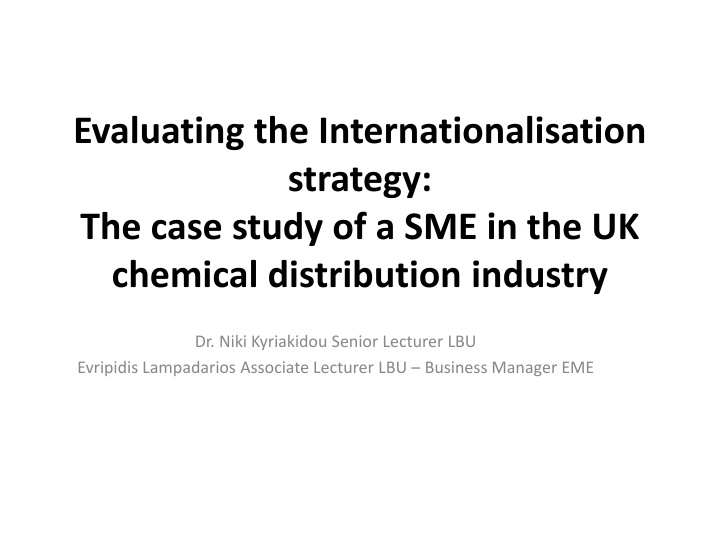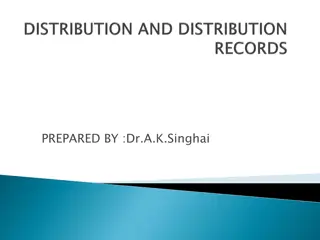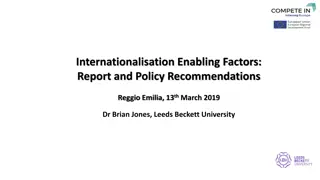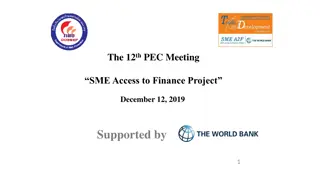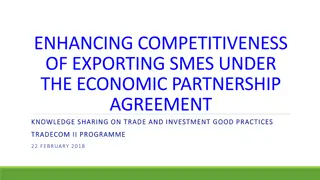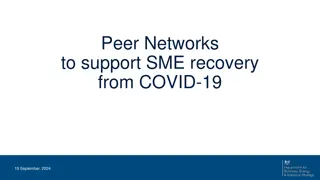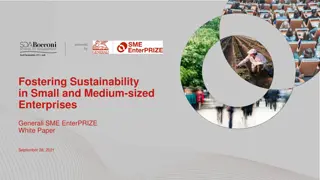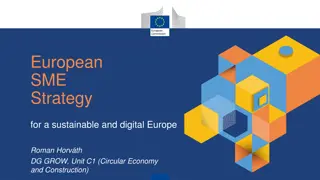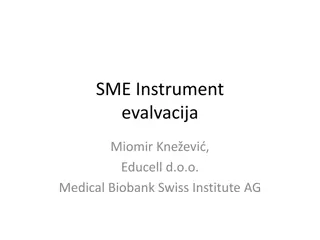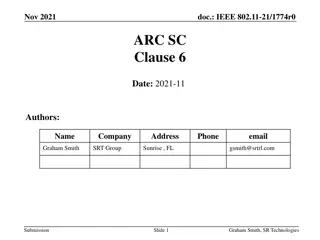Evaluating SME Internationalisation Strategy in UK Chemical Distribution
SMEs play a vital role in economic growth, and evaluating their internationalisation strategies, focusing on a UK chemical distribution SME as a case study, sheds light on factors contributing to success in this industry. Explore the significance, challenges, and potential for growth in SME internationalisation within this context.
Download Presentation

Please find below an Image/Link to download the presentation.
The content on the website is provided AS IS for your information and personal use only. It may not be sold, licensed, or shared on other websites without obtaining consent from the author.If you encounter any issues during the download, it is possible that the publisher has removed the file from their server.
You are allowed to download the files provided on this website for personal or commercial use, subject to the condition that they are used lawfully. All files are the property of their respective owners.
The content on the website is provided AS IS for your information and personal use only. It may not be sold, licensed, or shared on other websites without obtaining consent from the author.
E N D
Presentation Transcript
Evaluating the Internationalisation strategy: The case study of a SME in the UK chemical distribution industry Dr. Niki Kyriakidou Senior Lecturer LBU Evripidis Lampadarios Associate Lecturer LBU Business Manager EME
Outline Why SMEs? Why UK Chemical distribution? Why internationalisation? Why WSB as case study? Research questions Findings Contribution and future research
Why SMEs? Vehicle for invigorating the enterprise economy (Beaver and Carr, 2002; Dobbs and Hamilton, 2007; Holmes et al., 2010; Simpson et al., 2012; Unger et al., 2011) Integral to contemporary economic and social regeneration (Harrigan et al., 2011; Lussier and Halabi, 2010; Philip, 2011; Robson et al., 2009) Promote economic growth and increase a country s competitiveness and wealth (Amoros et al., 2013; Franco and Haase, 2010) Essential for the establishment of a solid industrial base (Arando et al., 2009; Dickson and Weaver, 2008; Harris and Gibson, 2006; Smallbone et al., 2010) Key driver to innovation and R&D (Azimzadeh et al., 2013; European Union, 2015; Halabi and Lussier, 2014; Robbins et al., 2000). Above all Employment generation (Dobbs and Hamilton, 2007; Galapova and McKie 2012; Raju et al., 2011; Smallbone and Wyer, 2000; Tilley and Tonge, 2003). Due to importance of small businesses to the stability and health of the society, an understanding of the factors contributory to their success is crucial (Blackburn and Kovalainen, 2009; Holmes et al., 2010; Halabi and Lussier, 2014; Philip, 2011; Raju et al., 2011).
Why UK Chemical distribution? No contemporary academic and business research Significant contributor to the UK economy and employment (turnover of GBP 4.43bn in 2014, 6.800 direct employees) Mature and well-established practise But still developing (growing at 5% per annum) Subject to strong consolidation Heavily supporting the chemical industry High level of fragmentation (over 280 in UK) Over 75% are SMEs (BCG, 2013; CBA, 2015; CEFIC, 2014; Chemagility, 2012 and 2015; Districonsult, 2013; FECC, 2015; Hornke, 2013)
Why internationalisation? Established as a success factor for SMEs (Dobbs and Hamilton, 2007; Bierly and Gallagher, 2007; Lee et al., 2012; Mudambi and Zahra, 2007; Pangarkar, 2008; Zhou et al., 2007) European chemical distributors (BCG, 2013; Districonsult, 2013; FECC, 2013; Chemagility, 2008)but only one study by Hornke (2012) Due to strong globalisation, expanding to other markets becomes critical to success (BCG, 2013; Chemagility, 2015; Eberhard, 2014) No research aiming at evaluating the internationalisation process of SMEs in the specific industry and the skills / capabilities required for success.
Why WSB as case study? Typical of the average SME in the UK CDI Established 1880 15m turnover; 13 employees based in North England 80% UK 20% export but looking to expand Operating in a wide and varied range of markets Representing large chemical manufacturers in the UK Trading under their own products and brands. Face-to-face in-depth interviews with 5 senior managers with exporting responsibilities and the Managing Director
Research Questions. Identify the internationalization process in the context of the UK chemical distribution industry Explore current practice in skills development Identify the key competences of international managers.
Internationalisation process Schools of thought Uppsala / Stage WSB is past the stage of no regular export activities but still in the initial phase of developing agencies. However, it seems that there is no strategy nor intention to create an offshore sales subsidiary and finally have overseas production facilities. Resource Based View WSB exploits unique resources (specialty chemical products that add value, are not commodities and thus difficult to source, difficult to replace and substitute due to extensive testing required). Foreign Direct Investment Limited option due to resource constraints (typical of SMEs). Network Not applicable, as there the process is not based on relationships, business networks, people and their connections. Born global Not applicable, WSB did not internationalise from inception and in multiple countries.
Internationalisation process There isn t one theory to explain the internationalisation process of WSB. The Uppsala / stage and RBV appear to be more applicable in line with Etemad and Wright (1999) that SME behaviour, as a holistic process, cannot be explained fully by any one existing theory and therefore insight must be drawn from various theoretical models.
Exploring managers skills and cultural awareness No formal and written internationalisation strategy No formal communication and processes established The internationalisation process was inherited through an acquisition and never developed properly Attitude towards internationalisations is 90% reactive and 10% proactive There is a strong focus in the UK market There is no training and skills development programme in place Training is informal, done on an ad-hoc basis. Managers identify their own needs and act accordingly However, there is also utilisation of external resources such as UKTI, chamber of commerce and some external advice No cultural awareness training; whatever elements are present are through the experience and long service of the managers .proves the point that WSB relies on the existing skills of its employees rather than developing them through a training programme
Key competences of international managers Cultural awareness Foreign market knowledge Language skills Negotiation Communication However: consistent use of agents to alleviate all the above .
Contribution and future research This research: addresses the gap in small business success in the UK chemical distribution industry fulfils the need for more empirical studies improves the understanding of the chemical distribution industry and of the small businesses operating in it. Future research: look at the whole UK and European industry / qualitative approach
References (I) Amor s, J. E., Bosma, N. S. and Levie, J. (2013) Ten Years of Global Entrepreneurship Monitor: Accomplishments and Prospects, International Journal of Entrepreneurial Venturing, Vol. 5, No. 2, pp. 120-152. Arando, S., Pena, I. and Verheul, I. (2009) Market entry of firms with different legal forms: an empirical test of the influence of institutional factors, International Entrepreneurship and Management Journal, Vol. 5 No. 1, pp. 77-95. Azimzadeh, S. M., Pitts, B., Ehsani, M. and Kordnaeij, A. (2013) The Vital Factors for Small and Medium Sized Sport Enterprises Start-ups, Asian Social Science, Vol. 9, No. 5, pp. 243-253. Beaver, G. and Carr, P. (2002) The enterprise culture: understanding a misunderstood concept, Journal of Strategic Change, Vol. 11, No. 2, pp. 105-113. Bierly, P. E. and Gallagher, S. (2007) Exploring alliance partner selection: fit, trust and strategic expediency, Long Range Planning, Vol. 40, pp. 134-153. Boston Consulting Group (2013) The Growing Opportunity for Chemical Distributors: Reducing complexicity for producers through tailored service offerings, [online], Available at: https://www.bcgperspectives.com/content/articles/process_industries_supply_chain_management_growing_opportunity_c hemical_distributors/#chapter1, [Accessed 20thFebruary 2014]. CEFIC (2014) Chemicals Trends report, [online], Available at: http://www.cefic.org/Documents/FactsAndFigures/Chemical%20Trends%20Report/Chemicals%20Trends%20Report.April.23 .2014.pdf, [Accessed 20thApril 2014]. Chemagility (2008) UK Chemical Distributor Market Report 2008: Information, Insight and analysis of the UK Chemical distribution industry, Surrey: Chemagility. Chemagility (2012) A Global Perspective on the World Chemical Distribution Market, First Panel Session: Chemical Distribution Industry Landscape, presented at the FECC Annual Congress, Lisbon, May 21-23rd, 2012, [online], Available at: http://www.assicconline.it/menu/documents/06_brown.pdf, [Accessed 29thMay 2015]. Chemagility (2015) United Kingdom Chemical Distribution Report 2015, Surrey: Chemagility. Chemical Business Association (CBA) (2015) [website], Available at: http://www.chemical.org.uk/aboutus.aspx, [Accessed 25thFebruary 2014]. Dickson, P. H. and Weaver, K. M. (2008) The role of the institutional environment in determining firm orientation towards entrepreneurial behaviour, International Entrepreneurship and Management Journal, Vol. 4, No. 4, pp. 467-483. Districonsult (2013) Old Game - New Rules? Chemical Distribution in the Age of Volatility, [online], Available at: http://www.districonsult.com/en/index-districonsult%2Bnewsletter-1- 34%2B~%2Bold%2Bgame%2Bnew%2Brules%2B2013.html, [Accessed: 27thFebruary 2014].
References (II) Dobbs M. and Hamilton R. T. (2007) Small business growth: recent evidence and new directions, International Journal of Entrepreneurial Behaviour and Research, Vol. 13, No. 5, pp. 296 322. European Union (2015) Fact and figures about the EU s Small and Medium Enterprise (SME), [online], Available at: http://ec.europa.eu/enterprise/policies/sme/facts-figures-analysis/index_en.htm, [Accessed 15thApril 2015]. Eberhard, G. (2014) Growth and consolidation, ICIS Chemical Business, July 21-27, pp. 44-46. Etemad, H. and Wright, R. W. (1999) Internationalization of SMEs: Management Responses to a Changing Environment, Journal of International Marketing, Vol. 7, pp. 4-10. FECC (2013) The Chemical distribution Sector in Europe [online] Fecc.org., Available at: http://www.fecc.org/fecc/about- fecc/the-chemical-distribution-sector-in-europe, [Accessed 9thMarch 2015]. FECC (2015) European business plan 2015, [online], Available at: http://www.fecc.org/fecc/images/stories/downloads/GTDP/2014/FECC_BusPlan_2015_def.pdf, [Accessed 20thFebruary 2015]. Franco, M., and Haase, H. (2010) Failure factors in small and medium-sized enterprises: qualitative study from an attributional perspective, International Entrepreneurship and Management Journal, Vol. 6, No. 4, pp. 503-521. Galabova, L. and McKie, L. (2012) 'The five fingers of my hand : human capital and well-being in SMEs, Personnel Review, Vol. 42, Iss. 6, pp. 662 - 683. Halabi, C. E. and Lussier, R. N. (2014) A model for predicting small firm performance, Journal of Small Business and Enterprise Development, Vol. 21, Iss. 1, pp. 4-25. Harrigan, P., Ramsey, E. and Ibbotson, P. (2011) Critical factors underpinning the e-CRM activities of SMEs, Journal of Marketing Management, Vol. 27, No. 5 6, pp. 503 529. Harris, M. L. and Gibson, S. G. (2006) Determining the common problems of early growth of small businesses in EastemNorth Carolina, SAM Advanced Management Journal, Vol. 71, No. 2, pp. 39-55. Holmes, P., Hunt, A. and Stone, I. (2010) An analysis of new firm survival using a hazard function, Applied Economics, Vol. 42, pp. 185-195. Hornke, M. (2013) The future of chemical distribution in Europe: Customer relations as key value lever, Journal of business Chemistry, Vol. 9, Iss. 2, pp. 65-66.
References (III) Hornke, M. (2012) Chemical Distribution 2012, [online], Available at http://www.chemanager- online.com/file/track/11755/1, [Accessed 20thFebruary 2014]. Lee, H., Kelley, D., Lee, J. and Lee, S. (2012) SME Survival: The Impact of Internationalization, Technology Resources and Alliances, Journal of Small Business Management, Vol. 50, pp. 1 19. Lussier, R. N. and Halabi C. E. (2010) Three-Country Comparison of the Business Success versus Failure Prediction Model, Journal of Small Business Management, Vol. 48, No. 3, pp. 360 377. Mudambi, R., and Zahra, S. A. (2007) The Survival of International New Ventures, Journal of International Business Studies, Vol. 38, No. 2, pp. 332 352. Pangarkar, N. (2008) Internationalization and performance of small and medium-sized enterprises, Journal of World Business, Vol. 43, pp. 475 485. Philip, M. (2011) Factors Affecting Business Success of Small & Medium Enterprises (SMEs), Entrepreneurship: Theory and Practice, Vol. 32, No. 4, pp. 635-657. Raju, P. S., Lonial, S. C., Crum, M. D. (2011) Market orientation in the context of SMEs: A conceptual framework, Journal of Business Research, Vol. 64, pp.1320 1326. Robbins, D. K., Pantuosco, L. J., Parker, D. F. and Fuller, B. K. (2000) An empirical assessment of the contribution of small business employment to US state economic performance, Small Business Economics, Vol. 15, No. 4, pp. 293-302. Robson, P. J., Wijbenga, F. and Parker, S. (2009) Entrepreneurship and policy, challenges and directions for future research, International Small Business Journal, Vol. 27, No. 5, pp. 531-535. Simpson, M., Padmore, J. and Newman, N. (2012) Towards a new model of success and performance in SMEs, International Journal of Entrepreneurial Behaviour and Research, Vol. 18, Iss. 3, pp. 264-285. Smallbone, D. and Wyer, P. (2000) Growth and development in the small firm, In: Carter, S. And James-Evans, D. (Eds), Enterprise and Small Business, Harlow: Prentice Hall. Smallbone, D., Welter, F., Voytovich, A. and Egorov, I. (2010) Government and entrepreneurship in transition economies: the case of small firms in business services in Ukraine, Service Industries Journal, Vol. 30, No. 5, pp. 655-670. Tilley, F. and Tonge, J. (2003) Introduction, In: Jones, O and Tilley, F. (eds), Competitive Advantage in SMEs: Organising for Innovation and Entrepreneurship, Chichester: John Wiley & Sons. Unger, J.M., Rauch, A., Frese, M. and Rosenbusch, N. (2011) Human capital and entrepreneurial success: A meta-analytical review, Journal of Business Venturing, Vol. 26, pp. 341-358. Zhou, L. X., Wu, W. P. and Luo, X. M. (2007) Internationalization and the performance of born-global SMEs: the mediating role of social networks, Journal of International Business Studies, Vol. 38, No. 4, pp. 673-679.
Thank you Any Questions?
